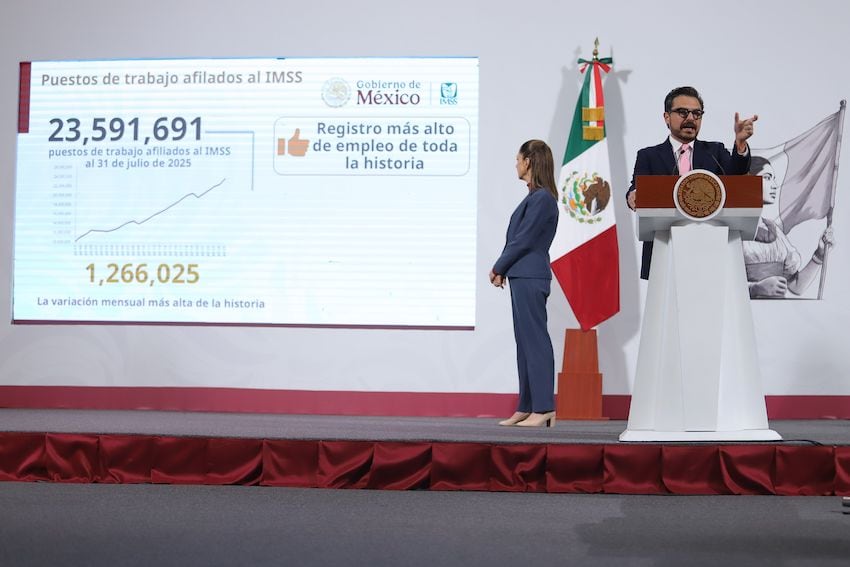Mexico added a record 1.26 million formal sector jobs in July, a surge driven by the launch of a pilot program that provides employment benefits to digital platform workers.
The number of workers registered with the Mexican Social Security Institute (IMSS) stood at a record 23.59 million on July 31, according to a statement issued by the government agency.
IMSS said that the month-over-month increase of 1.266 million formal sector jobs was “boosted by the commencement of a pilot program for digital platform workers.”
The six-month pilot program — made possible thanks to labor law reforms — began on July 1.
One of the 100 commitments President Claudia Sheinbaum made on the day she was sworn in was to make social security benefits mandatory for “workers of apps” such as Uber, DiDi and Rappi.
‘A true paradigm shift’
At Sheinbaum’s morning press conference on Wednesday, Deputy Labor Minister Quiahuitl Chávez Domínguez said that digital platforms began registering workers with IMSS on July 1.
She said that registered workers will have access to formal sector employment benefits, including medical and accident insurance, government childcare centers and pension and housing programs.
“We are facing a true paradigm shift. Technological innovation is no longer at odds with labor rights,” Chávez said.
Digital platform workers need to earn at least 8,480 pesos (US $456) per month to have full access to formal sector employment benefits. The vast majority of the 1.26 million jobs added in July corresponded to digital platform positions, but it is not yet known how many of the “app workers” met the salary threshold to qualify for full benefits. But regardless of how much they earn, all digital platform workers now, at the very least, have accident insurance.
New labor reform protects rideshare and other platform gig workers
Chávez said that the reform requiring the incorporation of gig workers to IMSS was supported by both digital platform companies and their workers.
“Now there are clear rules, there is social security and there are fair working conditions for everyone,” she said.
Chávez highlighted that digital platform workers registered with IMSS won’t lose their right to labor flexibility. In other words, they will continue to be able to choose their own schedules and won’t be required to work a minimum number of hours. They will not be required to pay any additional taxes.
IMSS director Zoé Robledo told Sheinbaum’s press conference that 90% of more than 1 million digital platform workers in Mexico are men, while just 10% are women.
He said that 56% of such workers are 35 or younger and 23% have other formal sector jobs.
“This is very important because for a long time it was thought that [digital] platform work was a complement to other jobs. However, what we see is that for 74% of people, it’s probable that they only dedicate themselves to platform work,” Robledo said.
He said that the breakdown of digital platform workers in Mexico is “practically 50-50” — i.e., half are drivers for rideshare companies and half are delivery drivers or riders.
1.35 million formal sector jobs added this year
IMSS reported that 1.353 million formal sector jobs were created between January and July. Mexico now has 6.1% more formal sector workers than at the end of 2024.

The addition of 1.26 million positions in July came after three consecutive months of formal sector job losses. Formal sector employment declined by almost 140,000 positions between April and June.
IMSS also reported that the number of people in formal sector jobs was 5.6% higher at the end of July than a year earlier.
Guillermina Rodriguez, senior vice president of economic studies at Banamex, told the newspaper El Economista that the annual growth in formal sector employment is mainly due to the registration of digital platform workers with IMSS.
She said that the incorporation of such works into the formal sector is “positive,” but their inclusion in the IMSS data “distorts the overall employment picture.”
In fact, data indicates that without the commencement of the pilot program for digital platform workers, the number of formal sector jobs in Mexico would have declined in July.
Most new formal sector jobs are not permanent positions
Of the 1.35 million formal sector jobs added this year, just 155,591 positions — 11.5% of the total — are permanent positions. The bulk of the new jobs are temporary, or contract, positions.
The creation of permanent formal sector jobs declined 51.7% compared to the first seven months of 2024.
Excluding 2020, when many jobs were lost during the COVID pandemic, it was the worst start to a year for permanent formal sector job creation since 2009.
México state and CDMX record largest job growth; 19 states went backwards
IMSS data shows that the number of formal sector jobs in México state — Mexico’s most populous state — increased 41.7% in the 12 months to July.
With 15.4% annual growth, Mexico City recorded the second-highest formal sector job creation rate.
The high formal sector job creation rates in the two entities are reflective of the high number of digital platform workers in the Mexico City metropolitan area, which includes many México state municipalities.
Ten other states recorded formal sector job growth in the 12 months to July. They were:
- Hidalgo (+3.1%)
- Michoacán (2.7%)
- Baja California Sur (2.3%)
- Aguascalientes (1.8%)
- Nuevo León (1.5%)
- Colima (1.4%)
- Quintana Roo (1.3%)
- Jalisco (0.8%)
- Guanajuato (0.3%)
- Querétaro (0.1%)
Puebla recorded a 0.0% annual formal sector job creation rate.
Of the 19 states that lost formal sector jobs in the 12 months to July, Tabasco saw the biggest drop, followed by Nayarit. The number of formal sector positions declined 9.6% in Tabasco and 3% in Nayarit.
Job creation by sector
IMSS reported that the number of formal transport and communication sector workers increased 71% in the 12 months to July. The increase is largely due to the registration of digital platform workers with IMSS.
The number of formal sector workers increased in four other sectors reported by IMSS.
- Business services (+5.4%)
- Commerce (2.7%)
- Electricity (1.8%)
- Social and community services (1%)
The workforces of the following sectors declined in the 12 months to July.
- Construction (-7.9%)
- Mining (-5.5%)
- Manufacturing (-1.6%)
- Agriculture (-0.7%)
What is the average daily wage of a formal sector worker?
IMSS reported that the average daily base salary of a formal sector worker was 614.3 pesos (US $33) at the end of July. That is more than double the daily minimum wage in most of the country, which is set at 278.80 pesos.
IMSS said that the average formal sector wage was up 4.3% in annual terms at the end of last month.
With reports from El Economista and Reforma
